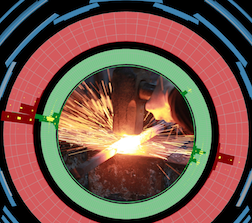In this talk we give an overview about the status and recent developments in the field of automated NLO calculations and their combination with Monte Carlo tools.
We will discuss the underlying ideas that have led to the NLO revolution and describe how these methods have been applied to actual calculations.
Finally we also give an outlook about possible future developments and challenges in this field.
Package-X is a Mathematica package designed to analytically compute dimensionally regularized one-loop Feynman Integrals. In this talk I will showcase many new features in the upcoming update, Package-X 2.0. Among them are (1) the ability to handle four propagator factors, (2) test for power infrared divergences, (3) construct Taylor series expansions, and many many more.
For more...
NLO Higgs (EW production) matched to parton shower
NLO Higgs gluon-fusion merged at NLO
first steps of uncertainty estimation
We study Higgs pair production with a subsequent decay to a pair of photons and a pair of bottom quarks at the LHC using the analysis tool MadMax. Based on the Neyman-Pearson Lemma, MadMax computes both the maximum significance for a signal extraction as well as its differential distribution. This allows us to better understand which phase space regions contribute to the extraction of the...
The use of NLO and multileg Monte Carlo generators by the ATLAS experiment in
the analysis of 13 TeV data is discussed. Procedures to validate these
generators by comparing results obtained using data collected at 7 TeV,
8 TeV and 13 TeV to the generator predictions are described. Techniques
used to evaluate systematic uncertainties on Monte Carlo modelling are
also discussed.
We present a classification of 4d rank 1 $\mathcal{N}=2$ Superconformal Field Theories (SCFTs), based on a geometrical analysis of the Coulomb Branches of these theories, i.e., their moduli space of vacua.
Supersymmetry and the residual $U(1)$ gauge symmetry on the Coulomb Branch allow us to constrain the geometries that can be consistently interpreted as low energy moduli space of a...
We discuss the diagonalization of the field theory hamiltonian by truncating the Hilbert space and using standard numerical diagonalization techniques. We show results of using this method in a simple $\lambda\phi^4$ theory. We discuss the long-term goal of using this diagonalization technique to calculate the S-matrix elements non-perturbatively. Finally, we briefly discuss Monte-Carlo and...
